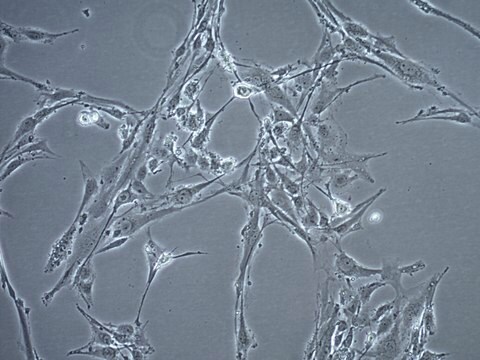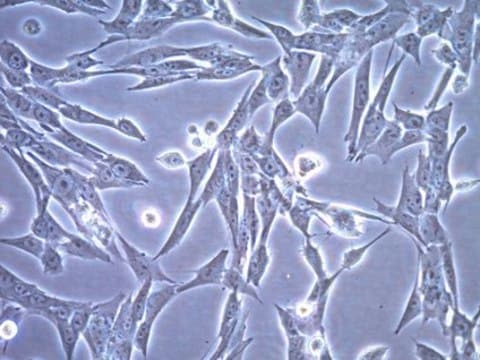SCC127M
SF8628 Human DIPG H3.3-K27M Cell Line
Human
Synonym(e):
SF-8628 cells
About This Item
Empfohlene Produkte
product name
SF8628 Human DIPG H3.3-K27M Cell Line, SF8628 pediatric diffuse intrinsic pontine glioma (DIPG) cell line harbors the histone H3.3 Lys 27-to-methionine (K27M) mutation and can support research and drug development efforts targeting DIPG.
Biologische Quelle
human
Qualitätsniveau
Methode(n)
cell culture | mammalian: suitable
Allgemeine Beschreibung
A somatic mutation of histone H3.3 resulting in a lysine 27 to methionine substitution (H3.3K27M) occurs in 60% of DIPG (2). In H3.3K27M DIPG patient samples, levels of H3K27 dimethylation (H3K27me2) and trimethylation (H3K27me3) are reduced globally. These epigenetic changes are thought to be important factors driving DIPG oncogenesis (2,3,4). Expression of H3.3K27M was also recently shown to be associated with increased levels of H3K27 acetylation (H3K27ac) and recruitment of bromodomain proteins at sites of active transcription (5). Treatment of H3.3K27M DIPG cells with a bromodomain and extra-terminal domain (BET) inhibitor was found to inhibit proliferation and induced differentiation. BET inhibitors are thus a promising therapeutic approach for the treatment of DIPG.
1. Schroeder KM et al. (2014) Pediatr. Res. 75(1-2): 205–209.
2. Lewis PW et al. (2013) Science 340(6134): 857–861.
3. Chan K-M et al. (2013) Genes & Development 27: 985-990.
4. Hashizume R et al. (2014) Nat Med. 20(12):1394-6.
5. Piunti A et al. (2017) Nat. Med. 23(4): 493-500.
6. Mueller S et al. (2014) Neuro Oncol. 16(3): 352-360.
Beschreibung der Zelllinie
Anwendung
Cancer
Oncology
Qualität
• Cells are tested negative for Epstein-Barr virus, HPV-16, HPV-18, Hepatitis A, C, Herpesvirus type 6, 7, 8 and HIV-1 & 2 viruses by PCR
• Cells are negative for mycoplasma contamination.
• Each lot of cells is genotyped by STR analysis to verify the unique identity of the cell line
Lagerung und Haltbarkeit
Haftungsausschluss
Lagerklassenschlüssel
10 - Combustible liquids
WGK
WGK 2
Flammpunkt (°F)
Not applicable
Flammpunkt (°C)
Not applicable
Analysenzertifikate (COA)
Suchen Sie nach Analysenzertifikate (COA), indem Sie die Lot-/Chargennummer des Produkts eingeben. Lot- und Chargennummern sind auf dem Produktetikett hinter den Wörtern ‘Lot’ oder ‘Batch’ (Lot oder Charge) zu finden.
Besitzen Sie dieses Produkt bereits?
In der Dokumentenbibliothek finden Sie die Dokumentation zu den Produkten, die Sie kürzlich erworben haben.
Unser Team von Wissenschaftlern verfügt über Erfahrung in allen Forschungsbereichen einschließlich Life Science, Materialwissenschaften, chemischer Synthese, Chromatographie, Analytik und vielen mehr..
Setzen Sie sich mit dem technischen Dienst in Verbindung.








